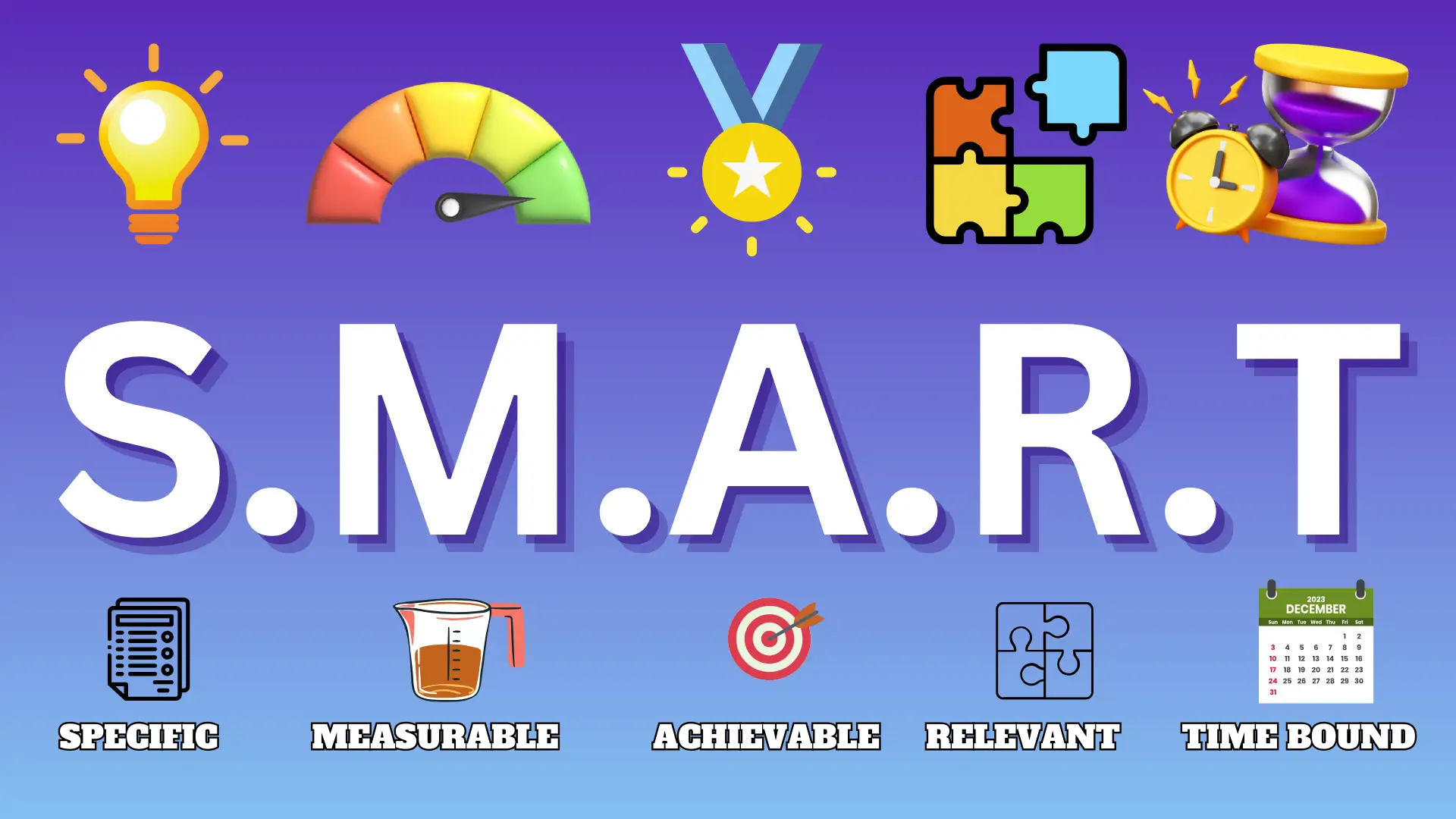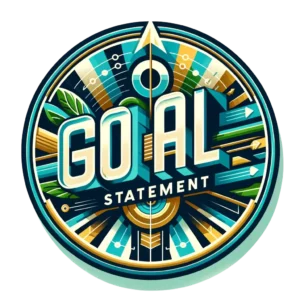Setting clear goals is important, but it can be tricky to figure out how to make them really effective. This SMART goal worksheet with examples will help you to set goals that are specific, measurable, achievable, relevant, and time-bound.
What does all that mean? Well, a specific goal clearly defines what you want to accomplish, like “I will exercise for 30 minutes, 5 days per week.”
Measurable means quantifying your goal so you can track progress, like tracking those 30-minute workout sessions on a calendar.
I have included a s.m.a.r.t goal worksheet for content marketing, fitness, and an eCommerce website as examples.
Here’s a basic template of a SMART goal worksheet pdf:
Setting a goal can really help provide direction and motivation. I find it helpful to make sure my goals are S.M.A.R.T:
Goal Statement:
- Write a clear and concise statement of the end goal you want to achieve.
Notes
Specific (S):
- Be clear on exactly what you’re trying to accomplish
- Get precise with the details – who’s involved, any constraints to think about?
- Getting precise helps make sure everyone understands the goal and can work towards it
Notes
Measurable (M):
- Have some way to track progress.
- This could be quantitative metrics or milestone check-ins.s?
- Measuring as you go helps stay on track and know when you’ve achieved the goal.
- How will you measure your progress and determine when the goal is achieved?
Notes
Achievable (A):
- Make sure the goal is realistic given available resources, skills, etc.
- Is the goal realistic and attainable given your resources, skills, and constraints?
- Breaking a big goal down into smaller steps can help make it feel more doable.
Notes
Relevant (R):
- Check that the goal aligns with broader objectives or values.
- Having alignment helps motivate and gives a clearer sense of purpose.
Notes
Time-Bound (T):
- Set a realistic deadline or milestones
- Timeframes create accountability and allow celebration when goals are accomplished!
- What is the deadline or timeframe for achieving this goal?
Notes
Of course, no goal or plan goes perfectly. Expect obstacles and be ready to adapt strategies.
Tracking progress makes it easier to adjust course as needed.
And don’t forget to celebrate successes along the way, not just the final achievement!
Its a good idea to have an action plan as if you fail to plan then you plan to fail – i know you’ve heard that before, but it is reality. If you don’t know how you’re going to do something, then you will not get there!
Action Plan:

Map Out the Steps
-
- Break down everything needed to reach the goal.
-
- I like to brainstorm all the tasks and milestones, then organize them into a timeline.
-
- Being granular really helps! And I try to identify the very next physical step – that makes it feel more manageable to get started.
 Assign Roles
Assign Roles
-
- Who will be working on which pieces?
-
- Making sure everyone knows their responsibilities sets things up for success.
-
- I also think about dependencies across teams.
-
- Clear ownership and coordination makes a big difference.
 Anticipate Roadblocks
Anticipate Roadblocks
-
- I try to get creative here – what might get in the way?
-
- Where are the vulnerabilities in the plan?
-
- Identifying pitfalls ahead of time makes them less scary.
-
- For big red flags, it helps to sketch out a plan B just in case.
Secure Needed Resources
-
- This one’s easy to overlook!
- Do we have the budget, equipment, permissions, etc. to pull this off?
- Getting clear on what’s needed to fully execute removes a big barrier.
- Better to know upfront if anything is at risk.
Track and Adjust
-
- I build in check-ins to review progress, usually every couple weeks or month.
-
- It’s motivating to see movement!
-
- And we might need to fine-tune certain steps based on how things are going.
-
- Course correcting is much easier if the tracking is consistent.
Stick to It
-
- Finally, I put the goal timeline somewhere visible as a reminder of the commitment.
-
- Anything that keeps me accountable when other priorities creep up.
-
- This plan got us excited for good reason – eyes on the prize!
Specific: Increase organic website traffic.
Measurable: By 20%.
Achievable: By optimizing existing content and publishing new blog posts.
Relevant: To drive more leads and conversions for our product.
Time-bound: Within the next 6 months.
This clear and well-defined goal provides direction and a way to track progress in a content marketing strategy.
To achieve the SMART goal you can use the following checklist:
Keyword Research and Strategy
[ ] Identify relevant keywords with high search volume and low competition.
[ ] Create a list of target keywords for your content.
Notes
Content Audit and Optimization
[ ] Perform a content audit to identify underperforming articles or pages.
[ ] Optimize existing content by updating keywords, improving readability, and adding fresh information.
Notes
Content Creation
[ ] Develop a content calendar with a mix of blog posts, articles, videos, infographics, etc.
[ ] Ensure that new content is high-quality, valuable, and aligned with target keywords.
Notes
On-Page SEO
[ ] Optimize meta titles, meta descriptions, and header tags for each piece of content.
[ ] Use internal linking to improve the site’s structure and navigation.
Notes
Quality Backlinks
[ ] Identify authoritative websites in your niche for potential backlink opportunities.
[ ] Create outreach strategies to build quality backlinks to your content.
Notes
Social Media Promotion
[ ] Share new and existing content on relevant social media platforms.
[ ] Engage with your niche audience on social media to encourage sharing and interaction.
Notes
Email Marketing
[ ] Promote new content through email newsletters to your subscriber list.
[ ] Include compelling calls to action in emails to drive traffic to your website.
Notes
Analytics and Monitoring
[ ] Set up Google Analytics to track website traffic and user behavior.
[ ] Regularly review analytics data to monitor progress toward the 20% increase.
Notes
A/B Testing
[ ] Experiment with different content formats, headlines, and CTAs to optimize performance.
[ ] Implement changes based on A/B test results.
Notes
Content Promotion Strategy
[ ] Develop a content promotion plan to reach a wider audience through guest posting, partnerships, or collaborations.
Notes
Continuous Learning and Improvement
[ ] Stay updated with industry trends and adjust your content strategy accordingly.
[ ] Analyze competitors’ strategies and adapt to remain competitive.
Notes
Reporting and Evaluation
[ ] Regularly report on key metrics and evaluate progress toward the 20% increase.
[ ] Adjust your strategy based on the data and results obtained.
Notes
By following this checklist, you’ll have a structured approach to achieving your SMART goal of increasing organic website traffic in your content marketing strategy. Remember to regularly review and adjust your tactics based on the performance data to ensure you stay on track toward your goal.
SMART Goal Worksheet for Personal Fitness:
Goal Statement:
To lose 10 pounds of body weight in the next three months to improve overall health and fitness.
Notes
Specific (S):
- What: Lose 10 pounds of body weight.
- Who: Myself.
- Resources/Constraints: Access to a gym, healthy meal planning, and time for regular workouts.
Notes
Measurable (M):
- How: Track progress by measuring weight loss each week.
- Metrics: Aim to lose approximately 1-2 pounds per week.
Notes
Achievable (A):
- Is it Realistic and Attainable? Yes, based on a healthy rate of weight loss.
- Actions/Steps:
- Commit to a regular exercise routine (3-4 times a week).
- Follow a balanced diet with reduced calorie intake.
- Stay hydrated and get enough sleep for recovery.
Notes
Relevant (R):
- Why: Improve overall health, increase energy levels, and boost self-confidence.
- Alignment: Aligns with long-term goal of maintaining a healthy lifestyle.
Notes
Time-Bound (T):
- Deadline: Achieve the goal within the next three months.
- Milestones: Track progress every two weeks to ensure on track.
Notes
Action Plan:
-
- Create a workout plan, including cardio and strength training exercises.
- Consult with a nutritionist to develop a personalized meal plan.
- Schedule workouts and meal prep time in a calendar.
- Purchase a food scale and tracking app for accurate portion control.
Notes
Potential Obstacles and Solutions:
-
- Challenge: Lack of motivation.
- Solution: Find a workout buddy or hire a personal trainer for accountability.
- Challenge: Social events with unhealthy food options.
- Solution: Plan ahead and bring healthy snacks to such events.
- Challenge: Lack of motivation.
Notes
Resources Needed:
-
- Gym membership or access to fitness equipment.
- Nutritionist consultation for meal planning.
- Budget for purchasing healthy food options.
Notes
Progress Tracking:
-
- Weekly weigh-ins every Sunday morning.
- Keep a food and exercise journal to monitor daily habits.
- Monthly check-ins with a personal trainer for fitness assessments.
Notes
Evaluation and Review:
-
- Evaluate progress every two weeks to ensure the goal is achievable within the three-month timeframe.
- Adjust the action plan as needed based on results and feedback from the nutritionist and trainer.
Notes
Conclusion and Commitment:
You can make a commitment to get things done in the following way by signing the checklist and make yourself accountable:-
I am committed to losing 10 pounds over the next three months by following the outlined action plan.
I understand the importance of regular exercise and a balanced diet in achieving this goal.
I will stay accountable and adjust my approach as necessary to succeed.
[Signature] [Date]
This SMART goals worksheet helps individuals break down a fitness goal into specific, manageable steps, making it easier to track progress and stay on course towards achieving the desired outcome.
SMART Goal Worksheet pdf for eCommerce Website
Goal Statement:
To improve the overall performance and profitability of our eCommerce store by optimizing key processes and increasing customer satisfaction.
Specific (S):
- What: Optimize eCommerce store processes and boost customer satisfaction.
- Who: eCommerce team and relevant stakeholders.
- Resources/Constraints: Access to eCommerce platform, analytics tools, budget for improvements.
Notes
Measurable (M):
- How: Measure performance using key performance indicators (KPIs).
- Metrics: Track metrics like conversion rate, average order value, customer retention rate, and customer feedback.
Notes
Achievable (A):
- Is it Realistic and Attainable? Yes, with a well-defined plan and allocation of resources.
- Actions/Steps:
- Conduct a thorough eCommerce website audit.
- Identify areas for improvement in customer experience, product listings, and checkout process.
- Allocate budget for necessary improvements.
Notes
Relevant (R):
- Why: Enhance customer satisfaction, increase sales, and maintain a competitive edge.
- Alignment: Aligned with the long-term eCommerce growth strategy.
Notes
Time-Bound (T):
- Deadline: Achieve improvements within the next six months.
- Milestones: Set monthly and quarterly targets for KPI improvements.
Notes
Action Plan:
- Website Audit and Analysis:
- Identify strengths and weaknesses in the current eCommerce setup.
- Evaluate website performance, user experience, and load times.
- Customer Journey Optimization:
- Analyze user behavior using analytics data.
- Make improvements to the website navigation, product listings, and search functionality.
- Checkout Process Streamlining:
- Review and simplify the checkout process.
- Implement one-click payment options for returning customers.
- Product Listings Enhancement:
- Update and optimize product descriptions, images, and reviews.
- Ensure product information is accurate and compelling.
- Customer Support and Feedback:
- Implement a customer feedback system.
- Address customer inquiries and concerns promptly.
- Marketing and Promotion Strategy:
- Develop and execute a marketing plan to attract and retain customers.
- Utilize social media and email marketing to engage with the audience.
Potential Obstacles and Solutions:
- Challenge: Limited budget for improvements.
-
- Solution: Prioritize and allocate budget to high-impact areas first.
- Challenge: Resistance to change from the team.
-
- Solution: Communicate the benefits of the improvements and involve the team in the decision-making process.
Resources Needed:
- eCommerce platform access and tools for analysis.
- Budget allocation for improvements.
- Team members and stakeholders for collaboration.
Progress Tracking:
- Regularly review KPIs and analytics data.
- Conduct monthly performance assessments and adjust strategies as needed.
Evaluation and Review:
- Evaluate progress against KPIs every month.
- Make necessary adjustments based on performance data and customer feedback.
Having these SMART criteria helps create a step-by-step plan to reach your goals. It also builds in accountability to actually stick to your plan. Using a worksheet keeps all this organized in one place so you can track your progress. Setting SMART goals takes some effort up front, but it’s worth it!








